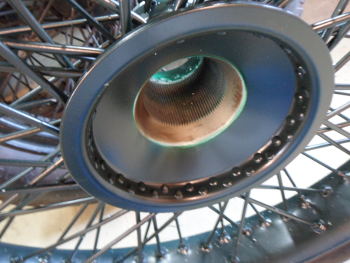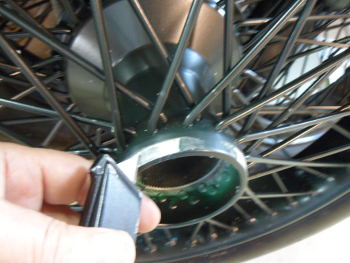Tips on fitting your wire wheels
There are a few basic things which should be observed when fitting a wire wheel with a splined centre (called Rudge Whitworth type) to the hub on the car.
Make sure the hub is free from dirt or any abrasive product - clean the hub and apply some Copper-slip to the splines and taper. I have found using a small stiff paintbrush is best for this. You can cut down the bristles if the brush isn't stiff enough. The wheel centre itself should be similarly treated. However before doing this ensure that there is no paint on either of the tapered surfaces on the wheel, and if there is scrape it off - see pictures.

I have experienced that paint on the front taper eventually gets worked and compressed to the extent that the wheel becomes loose, yet it is truly impossible to tighten the spinner at all in this state. The spinner needs to be undone wiped clean and and started again, so from my own experience it is critical to remove the paint on the front taper also, or keep a regular eye on things at least. Why not check your car after reading this!


Then apply a small amount of Copper-slip to the cleaned knock on which will contact the front taper of the hub, and tap in place.
An additional tip, which I have never come across written anywhere before. With the wheel not on the hub, count how many revolutions the knock on will rotate on the hub before bottoming, so when you then fit the wheel you can make sure the knock on is not bottoming before it is tightening onto the taper of the wheel. So recount the number of revolutions before tapping the spinner tight. I have been surprised by the number times I have come across a problem here, and how some hub lengths can vary on old wheel centres or new hubs. We had a French Jaguar XK owner who said his problems started when he fitted our new tyres, but he omitted to tell us he had also got all his suspension and hubs renewed, and the new hubs were longer and his old wheels and knock ons were pretty clapped out so nothing was ever properly tight, although the spinner was! As an aside, the wheels were in addition incorrectly balanced and we were surprised at the state of the old and patched up inner tubes people will use on their own cars!
Another useful tip while doing all this is to take note of how close the body of the wheel spinner is to the spokes. If they are very close or touching, this is a common cause for spoke breakages. For example some knock ons are made from brass (chrome plated) which over time stretch in use, especially when over tightened during their lifetime, but there can be other reasons for this also which will always be simple enough to rectify once you understand there is a problem.
And one final consideration if you've had a wire wheel conversion on your car ---just double check everything is on the right way around - ie the near side and off side hubs are on the correct sides, as otherwise no amount of tightening that eared knock on will stop your wheels eventually falling off, as a friend of mine found out years ago when he borrowed his dads Triumph TR4 which had recently had the steel wheels replaced for wire wheels !